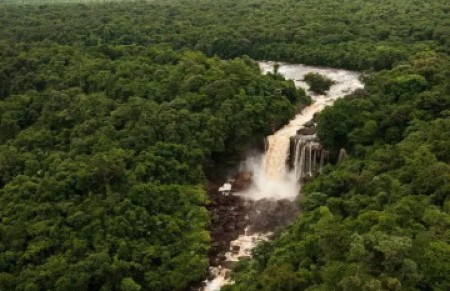Guyana Brings Hydro Power Project Back on Front Burner
GEORGETOWN, Guyana – The Guyana government says it is seeking to revive the 165 Megawatts (MW) Amaila Falls Hydropower project (AFHP) and hoping to start construction in 2022 with a completion date in 2025.
 Amaila FallsThe former coalition A Partnership for National Unity (APNU) in 2017 halted the project that had been started under a People’s Progressive Party (PPP) administration, expressing deep reservations about the cost, feasibility and other matters. This opposition to the project had resulted in the main investor, Sithe Global pulling out of the project on August 9, 2013.
Amaila FallsThe former coalition A Partnership for National Unity (APNU) in 2017 halted the project that had been started under a People’s Progressive Party (PPP) administration, expressing deep reservations about the cost, feasibility and other matters. This opposition to the project had resulted in the main investor, Sithe Global pulling out of the project on August 9, 2013.
A government statement said that the Office of the Prime Minister is looking for a partner to develop the project and has published a request for proposals, which outlines two options for the project’s development.
It said with the first option, Build-Own-Operate-Transfer (BOOT), all of the costs of the project up to the commissioning date would be borne by the developer, who would operate the project for a 20-year BOOT period. At the end of the BOOT period, the project would revert to the Government at no cost.
Under the second option, Design-Build-Finance (D-B-F), the developer would finance the development of the project up to commissioning date. The Government would take over the project and fulfill the financing repayment obligations, only upon and at satisfactory completion of construction and commissioning.
The statement said that the government expects submissions to contain proposals, including project costs, for each of the two options, and it will choose one.
“The development of the AFHP is needed to fulfill the current development and expansion plan of the Guyana Power and Light (GPL), which projects that total capacity required will be 465 MW and energy of 2,900 Gigawatts-hours (GHW) in 2025.
“The proposed completion date for the 165 MW AFHP would see it being completed one year after the 300 MW Gas-to-Shore project, which will supply at least 250 MW. Other sources include renewable energy projects (wind, solar and hydro) and heavy fuel oil (HFO). The Government intends for these to make up any balance or serve as back-up,” the statement added.


